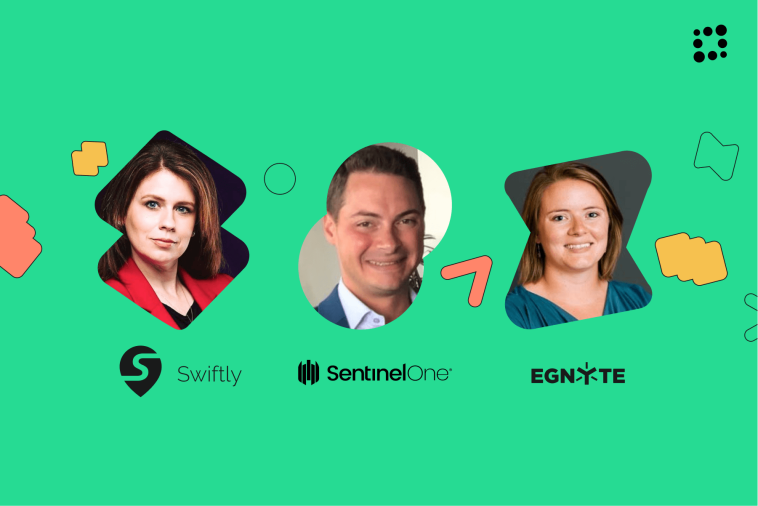- Like
- SHARE
- Digg
- Del
- Tumblr
- VKontakte
- Flattr
- Buffer
- Love This
- Save
- Odnoklassniki
- Meneame
- Blogger
- Amazon
- Yahoo Mail
- Gmail
- AOL
- Newsvine
- HackerNews
- Evernote
- MySpace
- Mail.ru
- Viadeo
- Line
- Comments
- Yummly
- SMS
- Viber
- Telegram
- JOIN
- Skype
- Facebook Messenger
- Kakao
- LiveJournal
- Yammer
- Edgar
- Fintel
- Mix
- Instapaper
- Copy Link
As we saw in our 2021 State of the Customer Success Industry and Salary Report, the role of Customer Success Manager (CSM) is one of the fastest-growing jobs in the industry. In a recent webinar titled “Navigating Your Customer Success Career Path”, Totango’s Sr. Director of Customer Success Robyn Fernandez spoke with three CS executives, including Swiftly’s Chief Customer Officer Maranda Dziekonski, Egnyte’s Manager of Customer Success Naomi Hawn, and SentinelOne’s Vice President of Customer Success Jack Daniel, about the steps they took to get to their current roles.
Some of the key takeaways from the webinar included:
- Always be listening, learning and growing.
- Challenge things honestly, be bold and be kind.
- Network internally to learn more about your product, processes, goals, etc.
- Raise your hand for new projects.
- Know when to say “yes” and when to say “no”.
- Focus on elevating those around you. Remember, we’re in the business of people.
- Don’t be afraid to admit what you don’t know, when you are wrong, or when you make a mistake. At times, it’s hard to do, but it will help you grow faster.
- Remember, there are no rules. Customer success is still new.
After the live webinar, the speakers participated in a Q&A session with audience members. Here is a recap of the Q&A and be sure to check out the webinar on-demand below.
How should a CSM go about making suggestions for process improvements they believe will help make their team and/or organization better?
NH: On our team, process improvement often comes from our individual contributors. I have found, though, when they have a list of ideas or things that need to be fixed, it can overwhelm management as every new process/idea has a LOT of change management that goes along with it. So, I would suggest partnering with your manager on some places you would like to help improve and seeing if they have any thoughts on prioritizing which ideas they would like to review with you first. This way, it can be taken in small, achievable chunks.
Do you think posting on LinkedIn helps with visibility within your company, especially if you’re new? And if so, do you have any tips on what to post?
JD: Absolutely! Most organizations are active on LinkedIn beyond marketing activities to promote hiring, share tidbits of company culture externally and to collaborate. I would start with liking other company posts, re-posting where appropriate and sharing your thoughts on them. Similarly, industry-specific or role-specific posts that are re-posted can provide some exposure and opportunities for team members to collaborate on ideas.
Our company is growing pretty quickly, which is exciting, but is also putting our lack of processes on full display and making it hard to keep up with scaling. Any tips on how to get started building these out?
NH: We were in the same boat five years ago, but we had to start somewhere. For us, we identified the biggest problem (CSMs had too many accounts to be proactive) and worked to create structure and processes around how many accounts CSMs had, what qualified a customer to have a CSM, and what the process was in assigning CSMs. Then, once we had approval, we worked to communicate and train the rest of the company on this new process. Once we laid this foundational work, we were able to target other areas of opportunity (such as training, QBRs, tools, cross-departmental partnerships, etc.).
In CS management, it’s clear that employee satisfaction can translate positively into customer satisfaction. How do you work to ensure there is an open feedback loop between your employees and leadership?
NH: As a manager, I am having regular (weekly or monthly) one-on-ones with my team members. I try to focus on getting their feedback on bandwidth, job satisfaction, frustrations and desire for future growth. I work to relay this overall sentiment to leadership. I feel it is my job to customize the requests/workload going to each of my team members based on my knowledge of their satisfaction sentiment to try and shield them from further degradation in satisfaction, and hopefully, work to improve it.
What advice do you have for folks in CS to level up their professional career in organizations with flatter hierarchies?
NH: We were like this for a long time. What I did was try to find the things I really enjoyed and take as much ownership as I was able and as the manager was able to give. For example, slowly creating a training program for new CSM onboarding, or creating best practices, deeper knowledge and product management relationships on an aspect of our product. When growing upwards isn’t a current feasible option, growing outwards is very satisfying and can lead to a lot of opportunities.
How long would you say it’s best to be in a CSM role before moving into a managerial position?
NH: I don’t have a suggestion on the “best” timeline. For me, I stayed in a CSM role longer than I perhaps needed to because I got so much fulfillment out of working with customers and the growth and challenges I was continuing to see here (and I still get to manage customers in my new role). I think that in order to do a good job managing, you need to be in the position long enough to have the seniority and experience to work with customers and internal executives. Being able to get experience in process creation and working on projects outside of the normal “CSM role” will give you good experience in preparation for a management role as well.
When you first got your CS roles, was the strategy already there? I work as a CSM with CS principles, but right now, the CS team is me, myself and I. Suggestions to make my company invest in the CS division to show my results to the board?
JD: In both of my recent CS roles, I was CS employee number 1, where there was no initial investment in tools or people. In both cases, I had to make justifications for initial purchases of tools and staffing before legitimizing the function. In my own experience, the best way to do this was to start with documenting the customer journey from sales order through renewal event. Then, show how the proposed investments will impact those processes and overall KPIs. It can quickly become evident that even smaller investments will have a large impact on retention and customer loyalty.





